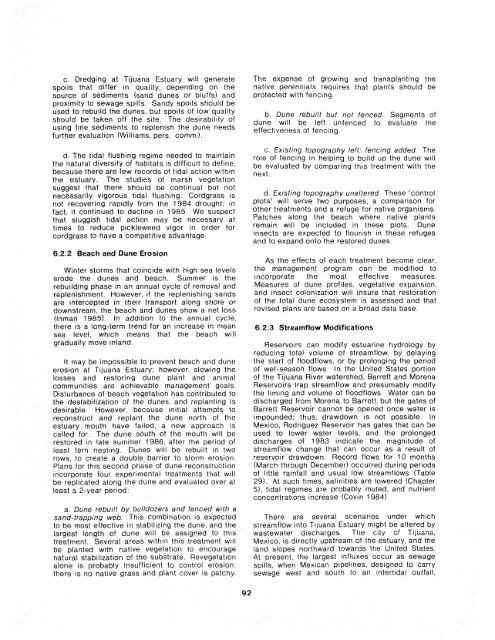The Ecology of Tijuana Estuary, California: An Estuarine Profile
The Ecology of Tijuana Estuary, California: An Estuarine Profile
The Ecology of Tijuana Estuary, California: An Estuarine Profile
Create successful ePaper yourself
Turn your PDF publications into a flip-book with our unique Google optimized e-Paper software.
c. Dredging at <strong>Tijuana</strong> <strong>Estuary</strong> will generate <strong>The</strong> expense <strong>of</strong> growing and transplanting the<br />
spoils that differ in quality, depending on the native perennials requires that plants should be<br />
source <strong>of</strong> sediments (sand dunes or bluffs) and protected with fencing.<br />
proximity to sewage spills. Sandy spoils should be<br />
used to rebuild the dunes, but spoils <strong>of</strong> low quality<br />
should be taken <strong>of</strong>f the site. <strong>The</strong> desirability <strong>of</strong><br />
b. Dune rebuilt but not fenced. Segments <strong>of</strong><br />
dune will be left unfenced to evaluate the<br />
using fine sediments to replenish the dune needs<br />
further evaluation (Williams, pers. comm.).<br />
effectiveness <strong>of</strong> fencing.<br />
c. Existing topography left; fencing added <strong>The</strong><br />
d. <strong>The</strong> tidal flushing regime needed to maintain role <strong>of</strong> fencing in helping to build up the dune will<br />
the natural diversity <strong>of</strong> habitats is difficult to define, be evaluated by this treatment with the<br />
because there are few records <strong>of</strong> tidal action within next.<br />
the estuary. <strong>The</strong> studies <strong>of</strong> marsh vegetation<br />
suggest that there should be continual but not<br />
necessarily vigorous tidal flushing Cordgrass is<br />
not recovering rapldly from the 1984 drought, in<br />
fact, it continued to decline In 1985 We suspect<br />
that sluggish tidal actlon may be necessary at<br />
times to reduce p~ckleweed vigor in order for<br />
cordgrass to have a competitive advantage<br />
6.2.2 Beach and Dune Erosion<br />
Winter storms that coincide with h~gh sea levels<br />
erode the dunes and beach Summer is the<br />
rebullding phase in an annual cycle <strong>of</strong> removal and<br />
replenishment However, ~f the replenishing sands<br />
are intercepted in therr transport along shore or<br />
downstream, the beach and dunes show a net loss<br />
(tnman 1985) In addlt~on to the annual cycle.<br />
there is a long-term trend for an Increase in mean<br />
sea level, whtch means that the beach will<br />
gradually move inland<br />
It may be impossible to prevent beach and dune<br />
erosion at <strong>Tijuana</strong> <strong>Estuary</strong>, however, slowtng the<br />
losses and restoring dune plant and animal<br />
commun~tles are achtevable management goals<br />
Disturbance <strong>of</strong> beach vegetation has contributed to<br />
the destabil~ratron <strong>of</strong> the dunes, and replanting IS<br />
des~rable. However, because initla1 attempts to<br />
reconstruct and replant the dune north <strong>of</strong> the<br />
estuary mouth have iarled, a new approach is<br />
called for <strong>The</strong> dune south <strong>of</strong> the mouth will be<br />
restored 111 late summer 1986, after the period <strong>of</strong><br />
least tern nesting Dunes will be rebuilt in two<br />
rows, to create a double barrler to storm erosion<br />
Plans for thrs second phase <strong>of</strong> dune reconstruction<br />
rncorporate four exper~mental treatments that will<br />
be repl~cated along the dune and evaluated over at<br />
least a 2-year period.<br />
a. Dune rebuilt by bulldozers and fenced with a<br />
sand-trapping web This combination is expected<br />
to be most effective In stabtlizing the dune, and the<br />
largest length <strong>of</strong> dune will be assigned ta thls<br />
treatment Several areas within th~s treatment will<br />
be planted wrth native vegetation to encourage<br />
natural stabilization <strong>of</strong> the substrate Revegetation<br />
alone rs probably insufficient to control erosion,<br />
there 1s no native grass and plant cover is patchy<br />
d. Existing topography unaltered. <strong>The</strong>se "control<br />
plots" will serve two purposes, a comparison for<br />
other treatments and a refuge for native organisms.<br />
Patches along the beach where native plants<br />
remain will be included in these plots. Dune<br />
insects are expected to flourish in these refuges<br />
and to expand onto the restored dunes.<br />
As the effects <strong>of</strong> each treatment become clear,<br />
the management program can be modified to<br />
incorporate the most effective measures.<br />
Measures <strong>of</strong> dune pr<strong>of</strong>iles, vegetative expansion,<br />
and insect colonization will insure that restoration<br />
<strong>of</strong> the total dune ecosystem is assessed and that<br />
revised plans are based on a broad data base.<br />
6.2.3 Streamflow Modifications<br />
Reservoirs can modify estuarine hydrology by<br />
reducing total volume <strong>of</strong> streamflow, by delaying<br />
the start <strong>of</strong> floodflows, or by prolonging the period<br />
<strong>of</strong> wet-season flows In the Unlted States portion<br />
<strong>of</strong> the Tljuana River watershed, Barrett and Morena<br />
Reservo~rs trap streamflow and presumably modify<br />
the timlng and volume <strong>of</strong> floodflows Water can be<br />
d~scharged from Morena to Barrett, but the gates <strong>of</strong><br />
Barrett Reservorr cannot be opened once water is<br />
impounded, thus, drawdown is not possible In<br />
Mex~co, Rodriguez Reservoir has gates that can be<br />
used to lower water levels, and the prolonged<br />
discharges <strong>of</strong> 1983 indicate the magnitude <strong>of</strong><br />
strearnflow change that can occur as a result <strong>of</strong><br />
reservoir drawdown Record ftows for 10 months<br />
(March through December) occurred during periods<br />
<strong>of</strong> little rainfall and usual low streamflows (Table<br />
29) At such times, salrn~tres are lowered (Chapter<br />
5), tidal regimes are probably muted, and nutr~ent<br />
concentrations increase (Covin 1984)<br />
<strong>The</strong>re are several scenarlos under which<br />
streamflow into <strong>Tijuana</strong> <strong>Estuary</strong> might be altered by<br />
wastewater disctlarges. <strong>The</strong> city <strong>of</strong> fijuana,<br />
Mexico. IS directly upstream <strong>of</strong> the estuary, and the<br />
land slopes northward towards the United States.<br />
At present, the largest influxes occur as sewage<br />
spi!ls, when Mexican pipelines, designed to carry<br />
sewage west and south to an ~ntertrdal outfall.

















